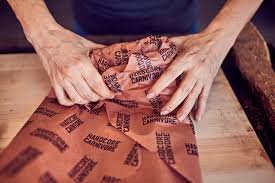The way to begin packaging design is deciding why you need to lay out. Businesses that use custom butcher paper do so in search of both convenience and branding. When the space between characters is well balanced, the repetition of designs and their alignment, each piece of paper will produce the same visual quality. Placing designs should be done critically, as unutilized space will diminish efficiency. It is grid-based to assist in alignment. Developing prototypes prior to the completion of large runs also eliminates expensive mistakes. Even little changes can create a huge difference in the effect on branding.
Design Flow
Any design must have a clear flow. When custom butcher paper wholesale" is used, logos, text, or icons must be mapped out in terms of their locations on the paper. The key to making sure that your brand is visible through various wrapping sizes is repetition. Designers cannot put important sizes too close to the edges because during the production of the product, they can be bent. The repetitive branding marks or patterns must pursue organized intervals to increase visibility. The freedom between elements will be consistent so that each section of the sheet does not appear disorganized. Such a flow gives the paper a professional look and, at the same time, makes it useful to wrap products.
Sheet Alignment
Alignment is important when staff members deal with butcher paper sheets. Sheets are usually variously sliced to standard sizes;s, however, the layout needs to be adjusted to different uses. The balanced branding offered by centered logos is combined with the active allure of diagonal patterns. Businesses that require flexibility ought to design layouts that are compatible with small as well as large amounts of paper. To prevent trimming, edge safety margins are warranted. Fine-tuning eliminates distortion and generates consistency between batches. The aim is storage uniformity across every sheet, irrespective of the level of production.
Roll Efficiency
When it comes to businesses that use butcher paper in the form of a roll, layout optimization dictates the extent to which branding can repeat along a long length. Rolls require designs that are smooth without interruptions or troublesome partitioning. The repeating pattern technique makes sure that there is no gap in the design. Rolls also require additional consideration of the printing orientation since improper orientation may result in no material being wasted. Continuous patterns usually prove more useful than when used individually in a graphic since they can fit a range of wrapping purposes. Repeats can also be varied to achieve cost versus visual balance. Roll layout design must be efficient with the maximum design impact.
Wholesale Impact
Bulk ordering businesses aim at achieving the best layout to minimize costs and brand consistency. When using custom butcher paper wholesale, the most important thing is the weight of the print and the coverage. Layouts featuring repeated branding graphics limit printing costs over the heavy-ink layouts. Minor layout flaws are enlarged at the wholesale scale, where accuracy is of utmost importance. A consistent brand color and pattern also help to sustain trust with customers. Wholesale layouts are tried on smaller quantities by many companies before the risky venture of large volume is undertaken. The implementation of optimized wholesale layouts is cost-saving, but does not compromise overall brand identity on each sheet.
Brand Focus
A layout must be appealing with a sense of balance and simplicity. A set of butcher paper packaging not only has its practical uses, but also conveys professionalism. Both the excessively detailed layouts may end up stealing focus away. There is a cleaner and consistent design. Strategic placement of logos, icons, or slogans must be made so they will attract without drowning the wrapping. Visual hierarchy: This makes the part of branding seem dominant, and the secondary design elements build appeal to the background. Not only should the values and style of the business be reflected in layouts, but layouts must always be appealing. The output is thoughtful and designed packaging.
Visual Consistency
Effective packaging is based on consistency. Wrapping custom printing on butcher paper of standard layout ensures a smooth appearance of all items wrapped. The design logic in each sheet or roll should be reinforced. Poor dissimilarity or inconsistency of patterns and spacing undermines brand perception. Simulation under actual charging conditions gives an indication of the behavior of the testing layouts in construction. Spacing, logo size, or repeat distance may require changes after testing. Being consistent helps businesses build credible experiences for customers. Layout optimization would result in practical and beautiful packages.
Layout Balance
Working with packaging, the work is based on balance. In the case of custom deli paper sheets, the layout should not really physiologically concentrate on placing objects on a single side and blank on a different side. Even spacing means that the design would look even and attractive regardless of how the sheet is folded or cut. To create harmony, designers need to ensure the logos and patterns are spaced. The diagonal position is dynamic, and vertical or horizontal is structural in nature. The layouts are balanced without any distraction and produce wrapping that is professional in all applications.
Conclusion
Laying out the package keeps your installed design viable, efficient, and brand-oriented. Custom butcher paper can do something other than wrapping: it can be part of your brand, with the right approach. Trial, err, or fine-tuning allows companies to be consistent in sheets and rolls. Extra care should be put towards detail in bulk orders because even the tiniest design components could be replicated thousands of times over. Wrapping is full of visual and operational content when properly optimized for layouts. The thriving of strategic planning results in credible outputs and builds faith and credibility with the customers.
